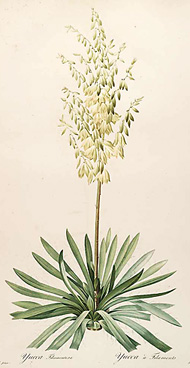Yack about Yucca
by Audrey Stallsmith

The stately yucca stands abloom,
Her beauty all may see
But the secret that her bells can tell
Is heard by none but me.
"The Yucca Path" by Cornelia Ashley
I feel a pang of envy whenever I see other people’s yuccas blooming this month, with their soldier-straight, torch-like panicles of white or cream bell-shaped flowers. Although mine has flowered off and on in the past, it’s usually more off than on!
This appears to be a common complaint with other gardeners too. Apparently each individual crown dies after it flowers, though most clumps are made up of more than one crown. Perhaps it sometimes takes a while for the side crowns to grow large enough to bloom.
My clump also has become heavily shaded, which probably doesn’t help. Most of the yuccas I’ve seen blooming appear to be growing in full sun. Unfortunately, they don’t like being moved and may sulk for a while after such transplanting, so I'm not sure that changing my plants' location would convince them to flower!
They derive their genus name from the Spanish yuca ("cassava"), but actually don't belong to the Manihot family. I'm guessing that the type most often seen here in Pennsylvania probably is Yucca filamentosa ("furnished with threads"), the largest hardy species, which thrives as far north as Zone 4.
It also is known as "Adam’s needle and thread" due to the white fibers that line and eventually fray the edges of its sword-shaped leaves. Those clumps of leaves can grow to 2 or 3 feet while the bloom stalk may shoot up as high as 8 feet or more.
The plant is native to the southeastern U. S., from about North Carolina to Florida, and Thomas Jefferson grew it in his garden as early as 1794. It also was popular during the Victorian era for its tropical appearance. According to Dirr’s Encyclopedia of Trees and Shrubs, the yuccas flaccida ("soft"), glauca ("having gray or blue leaves"), and smalliana ("small") are hardy as well--to at least zone 5--but shorter.
Yucca’s fibrous leaves once were used as paintbrushes or the individual fibers separated for the making of ropes, cloth, etc. In his Handbook of Edible Weeds, James Duke mentions that he has eaten yucca flower buds and reports that they taste like raw green beans.
Although some people eat other parts of the plant as well, the beaten roots reportedly are toxic enough to stun fish and the juice of the leaves has been used as an arrow poison. So I suspect a yucca supper could make you sick unless you know what you are doing.
Also, the plant is high in steroidal saponins (soaps) and estrogens, which could render it especially harmful to some people. So I would enjoy its statuesque good looks without trying to turn it into a vegetable!
The Yucca filamentosa image is from Les Liliacees by P. J. Redoute, courtesy of plantillustrations.org.








